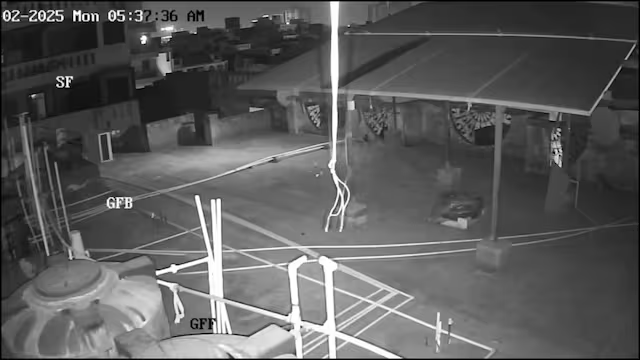On the early morning of February 17, 2025, Delhi and its adjoining National Capital Region (NCR) experienced tremors that served as a stark reminder of the inherent seismic vulnerability of the area. This earthquake in delhi ncr today—measured at 4.0 on the Richter scale—sparked a flurry of reactions among residents, experts, and government officials alike. In this blog, we break down the event point by point, discuss its causes, share first-hand observations, and outline measures for safety and preparedness, all while focusing on the keyword “earthquake in delhi ncr today.”

1. Introduction and Overview
- Event Summary:
On February 17, 2025, a moderate tremor—one of the notable earthquake in delhi ncr today—struck the Delhi-NCR region at approximately 5:36 AM. Although the tremors were strong enough to awaken many residents, the quake did not result in any significant casualties or major structural damage. - Magnitude & Epicentre:
- Magnitude: 4.0 on the Richter scale.
- Depth: A shallow focus at around 5 km beneath the surface.
- Epicentre Location: Near Durgabai Deshmukh College of Special Education in Dhaula Kuan, Delhi, the epicentre of this earthquake in delhi ncr today.
- (Source: hindustantimes.com)
- Immediate Reactions:
Residents rushed out of their homes and high-rise buildings as the ground vibrated. Many described the experience as both startling and unnerving, a typical reaction witnessed during an earthquake in delhi ncr today.
2. Timeline of Key Events
- Pre-Dawn Alert (Approximately 5:36 AM):
- The earthquake in delhi ncr today struck unexpectedly in the early hours, catching many off guard as most residents were either sleeping or just beginning their day.
- A series of low rumbling sounds preceded the main tremor, alerting people to the impending jolt.
- Initial Tremors:
- People felt strong shaking throughout their homes and workplaces, the hallmark of an earthquake in delhi ncr today.
- Some reported a sensation akin to a train rumbling underground—a clear indication of the force behind this seismic event.
- Immediate Aftermath:
- Within minutes of the earthquake in delhi ncr today, residents evacuated their buildings and gathered in open spaces.
- Emergency services and local authorities began monitoring the situation closely.
- Prime Minister Narendra Modi and other government officials addressed the nation on social media, urging calm and vigilance.
- (Source: hindustantimes.com; timesofindia.indiatimes.com)
- Subsequent Updates:
- Experts confirmed that no significant damage had occurred despite the intensity of this earthquake in delhi ncr today.
- Authorities advised residents to be prepared for potential aftershocks, though none were reported to be strong enough to cause additional panic.
3. Scientific Explanation: Why Did This Earthquake Happen?
- Seismic Basics:
- Tectonic Activity:
Earthquakes occur when stress along geological faults is suddenly released in the form of seismic waves. The earthquake in delhi ncr today occurred along a shallow fault line in the region. - Shallow Focus & Energy Amplification:
Due to its shallow depth of 5 km, the energy of this earthquake in delhi ncr today reached the surface more directly, amplifying the shaking and the associated rumbling sounds.
- Tectonic Activity:
- Sound and Vibration Phenomenon:
- Primary (P) Waves:
The first waves to travel from the earthquake’s focus are P waves. These compressional waves can move through both solid and liquid materials. - Rumbling Sound:
As the P waves reached the surface, they caused the ground to vibrate. These vibrations were transmitted as sound waves in the air—resulting in the rumbling noise that many residents reported during this earthquake in delhi ncr today.- (Source: timesofindia.indiatimes.com)
- Primary (P) Waves:
- Delhi’s Geology and Seismic Vulnerability:
- Delhi lies in a seismically active zone (classified as Zone IV in India’s seismic map), meaning that moderate to strong tremors, such as this earthquake in delhi ncr today, are not uncommon.
- Several fault lines, including the Delhi-Haridwar Ridge and the Delhi-Moradabad Fault, run near the region, predisposing it to frequent, though often low-magnitude, seismic events.
4. Impact on Daily Life and Infrastructure
- Resident Experiences:
- Immediate Evacuation:
Many people left their homes immediately after feeling the tremors associated with this earthquake in delhi ncr today, fearing potential building collapses. In some cases, parents hurried out with their children to ensure their safety. - Mixed Reactions:
While some residents expressed panic and confusion, others recalled previous minor tremors and remained relatively calm.- “I felt a sudden, strong jolt that made me step out onto the street immediately. Even though no one was hurt, it was a shocking experience during this earthquake in delhi ncr today,” said one resident from Nehru Nagar.
- Immediate Evacuation:
- Structural Observations:
- High-Rise Buildings:
Many high-rise structures in Delhi, Noida, and Ghaziabad experienced noticeable shaking. However, thanks to strict building codes in urban areas, significant damage was largely avoided during this earthquake in delhi ncr today. - Minor Incidents:
There were scattered reports of items being knocked over or minor cracks in older structures. No major infrastructural damage was reported.
- High-Rise Buildings:
- Public Safety Concerns:
- Residents voiced concerns about the preparedness of local infrastructure to withstand future, potentially stronger quakes. The earthquake in delhi ncr today has reignited discussions on urban safety.
- Authorities reassured the public that ongoing efforts to upgrade infrastructure and emergency response systems are in place to mitigate risks.
5. Government and Expert Response
- Official Statements:
- Prime Minister’s Address:
In response to the earthquake in delhi ncr today, PM Narendra Modi took to social media (X) to update the nation. He advised residents to remain calm and vigilant, and he mentioned that experts were closely monitoring the situation for any signs of aftershocks. - Emergency Measures:
Local authorities activated emergency helplines and safety protocols immediately following the earthquake in delhi ncr today. The Delhi Police, along with the National Centre for Seismology (NCS), provided live updates to keep the public informed.- (Source: hindustantimes.com)
- Prime Minister’s Address:
- Expert Analysis:
- Seismologists explained that while a 4.0 magnitude quake is relatively moderate, its shallow depth can result in perceptibly stronger shaking—a common trait seen in an earthquake in delhi ncr today.
- Experts reiterated that such tremors are not uncommon in Delhi due to the city’s proximity to major fault lines and its unique geological composition.
- Recommendations Issued:
- Residents were advised to remain outdoors until the shaking stopped completely and to avoid entering potentially damaged structures.
- Emergency preparedness drills and updated guidelines were circulated to help citizens better respond to future events similar to this earthquake in delhi ncr today.
6. Delhi’s Seismic Vulnerability: Why the Capital is Prone to Earthquakes
- Geographical and Geological Factors:
- Seismic Zone Classification:
Delhi is classified under seismic Zone IV—a “high-risk” area with relatively frequent earthquake occurrences, making the earthquake in delhi ncr today part of a broader pattern. - Fault Lines in the Region:
Multiple geological faults, including the Delhi-Haridwar Ridge, Mahendragarh-Dehradun Fault, and the Delhi-Moradabad Fault, contribute to the seismic activity that leads to events like this earthquake in delhi ncr today. - Historical Seismic Activity:
- Delhi has experienced several moderate tremors in the past, with occasional reports of stronger quakes originating from the Himalayas, Afghanistan, or even as far as Tibet.
- Historical records indicate that while devastating earthquakes are rare, the cumulative risk necessitates ongoing vigilance and preparedness, especially in the wake of an earthquake in delhi ncr today.
- Seismic Zone Classification:
- Urban Challenges:
- Rapid Urbanization:
With rapid growth in the metropolitan area, the pressure on infrastructure increases. While modern constructions adhere to strict seismic codes, older buildings may not be as resilient to an earthquake in delhi ncr today. - Population Density:
The high population density in Delhi means that even a moderate tremor can lead to significant public distress, underscoring the importance of well-coordinated emergency responses when an earthquake in delhi ncr today occurs.
- Rapid Urbanization:
7. Safety Tips During and After an Earthquake
To minimize risks during seismic events such as this earthquake in delhi ncr today, both residents and authorities should follow key safety protocols. Here are some essential tips, presented point-wise for clarity:
- Before an Earthquake:
- Identify Safe Spots:
- Locate sturdy furniture or under-table areas where you can take cover.
- Identify safe exit routes in your home or office.
- Emergency Kit:
- Keep an emergency kit stocked with water, non-perishable food, a first-aid kit, flashlight, batteries, and essential documents.
- Home Preparedness:
- Secure heavy furniture, appliances, and shelves to walls.
- Ensure that your home is retrofitted, if possible, to withstand the seismic forces characteristic of an earthquake in delhi ncr today.
- Identify Safe Spots:
- During an Earthquake:
- Drop, Cover, and Hold On:
- Drop to the ground, take cover under sturdy furniture, and hold on until the shaking stops.
- Stay away from windows, mirrors, or heavy objects that might fall during an earthquake in delhi ncr today.
- Evacuate Safely:
- If indoors, remain there until the shaking subsides before cautiously moving outside.
- If outdoors, move to an open space away from buildings, trees, and utility wires.
- Protect Your Head and Neck:
- Use your arms or a cushion to shield your head and neck from falling debris.
- Drop, Cover, and Hold On:
- After an Earthquake:
- Check for Injuries:
- Provide first aid where necessary and call emergency services for severe injuries.
- Inspect Your Environment:
- Check for structural damage or gas leaks and report them immediately to authorities.
- Expect Aftershocks:
- Remain cautious, as aftershocks can follow the main tremor—a common occurrence after an earthquake in delhi ncr today.
- Stay Informed:
- Listen to local news or follow official social media updates for further instructions.
- Check for Injuries:
By following these safety measures, residents can significantly reduce the risk of injury during an earthquake in delhi ncr today and future seismic events.
8. Future Preparedness: Strengthening Delhi’s Resilience
- Upgrading Infrastructure:
- Building Codes:
Continued enforcement and upgrading of building codes are critical. New constructions must adhere to seismic safety standards to better withstand future tremors like those seen in an earthquake in delhi ncr today. - Retrofitting Old Structures:
Both government and private initiatives should prioritize retrofitting older buildings and infrastructures to ensure they are earthquake-resilient, especially considering the recurring nature of an earthquake in delhi ncr today. - Urban Planning:
City planners must incorporate seismic risks when designing urban layouts, including wider roads and open spaces that can serve as evacuation zones during an earthquake in delhi ncr today.
- Building Codes:
- Community Awareness and Drills:
- Regular Drills:
Conducting regular earthquake drills in schools, offices, and residential communities instills a culture of preparedness for events such as an earthquake in delhi ncr today. - Public Awareness Campaigns:
Authorities should run campaigns educating citizens about the risks and emphasizing the importance of having an emergency plan in place, particularly in light of an earthquake in delhi ncr today. - Training Programs:
Training local responders and community volunteers can further strengthen the overall emergency response system in preparation for any future earthquake in delhi ncr today.
- Regular Drills:
- Governmental Role:
- Monitoring Systems:
Investment in advanced seismic monitoring systems by the National Centre for Seismology will allow for quicker detection and response to events such as an earthquake in delhi ncr today. - Emergency Response Coordination:
A robust, well-coordinated response involving police, fire services, and medical teams is essential to manage any potential fallout from future tremors. - Policy Initiatives:
Formulating policies that focus on disaster management and infrastructure resilience will ensure long-term safety and stability for Delhi, especially when facing an earthquake in delhi ncr today.
- Monitoring Systems:
9. Reflections and Lessons Learned
- Immediate Lessons from the Event:
- Although the 4.0 magnitude earthquake did not result in major casualties or extensive damage, this earthquake in delhi ncr today served as a potent reminder of Delhi’s vulnerability.
- The event highlighted the need for improved preparedness—not only at the governmental level, but also within communities and individual households.
- Importance of Vigilance:
- Regular seismic activity, even if minor, should prompt continual vigilance and periodic updates to safety protocols in case of another earthquake in delhi ncr today.
- Learning from past tremors can help refine emergency responses and reduce panic in future events.
- Community Resilience:
- The quick evacuation and collective response of Delhi’s residents during this earthquake in delhi ncr today underscore the strength and resilience of the local community.
- Building stronger community networks and emergency response groups can further enhance resilience against seismic events.
- Scientific and Technological Advances:
- Advances in seismology and monitoring technology play a crucial role in early detection. The earthquake in delhi ncr today demonstrates the value of these systems in issuing timely alerts and disseminating information.
- Ongoing research into seismic behavior, especially in urban areas like Delhi, will help tailor safety measures more effectively and prepare the city for future occurrences.
10. Conclusion
The February 17, 2025 earthquake in Delhi-NCR, though moderate in magnitude, left an indelible impression on the residents of the capital. Through this detailed point-wise analysis of the earthquake in delhi ncr today, we have examined how the event unfolded, delved into the science behind the tremors, and discussed the immediate and long-term implications for the city.
Key Takeaways:
- Awareness: Even a moderate quake, such as this earthquake in delhi ncr today, can cause widespread panic. Regular awareness and preparedness are vital to saving lives.
- Resilience: Although Delhi’s modern infrastructure largely withstood the tremors, continuous improvements and retrofitting are necessary to address existing vulnerabilities.
- Collaboration: Effective coordination between the government, emergency services, and citizens is crucial to minimizing the impact of future seismic events, including another earthquake in delhi ncr today.
- Preparedness: Being well-informed and having a clear, actionable plan—both on an individual and community level—can significantly mitigate the risks associated with earthquakes.
This incident should serve as a catalyst for a renewed focus on disaster preparedness in one of India’s most vibrant and densely populated cities. By understanding the underlying causes and reinforcing safety measures, Delhi can better safeguard its people and infrastructure against nature’s unpredictable forces and be more resilient the next time an earthquake in delhi ncr today occurs.
As we reflect on this event, let us remember that while earthquakes cannot be prevented, thorough preparation can reduce their impact. With proactive planning, community cooperation, and robust governmental policies, Delhi can shine in the face of challenges, turning the experience of an earthquake in delhi ncr today into a lesson for building a safer future.



